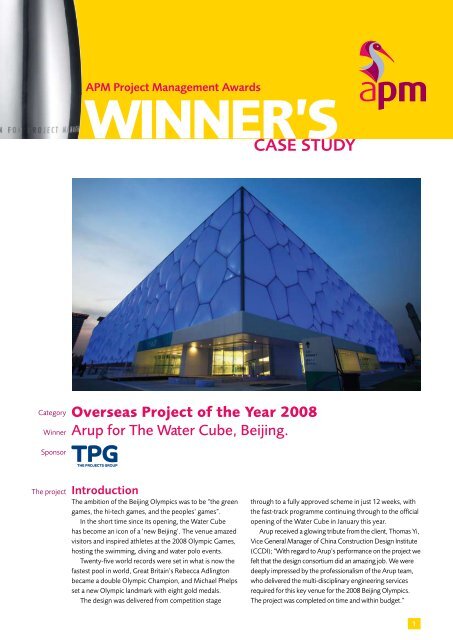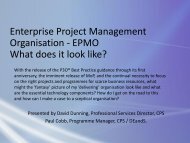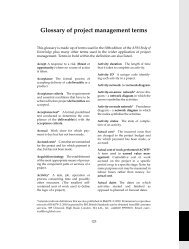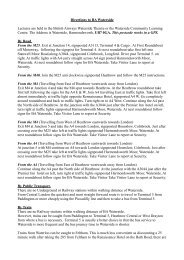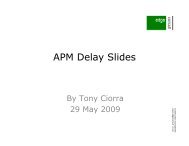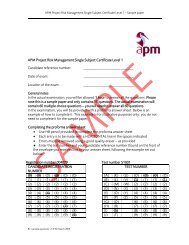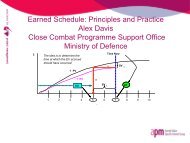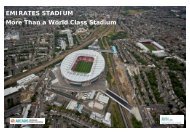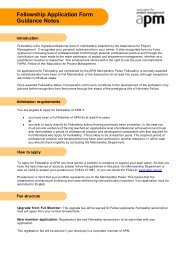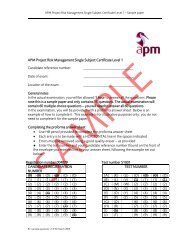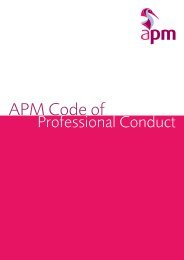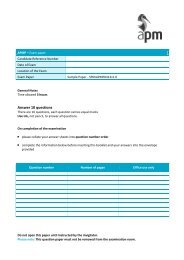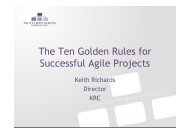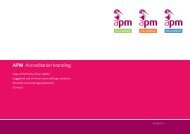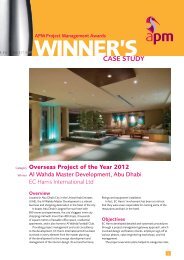Read the full case study here - Association for Project Management
Read the full case study here - Association for Project Management
Read the full case study here - Association for Project Management
Create successful ePaper yourself
Turn your PDF publications into a flip-book with our unique Google optimized e-Paper software.
APM <strong>Project</strong> <strong>Management</strong> Awards<br />
WINNER’S<br />
CASE STUDY<br />
Category<br />
Winner<br />
Overseas <strong>Project</strong> of <strong>the</strong> Year 2008<br />
Arup <strong>for</strong> The Water Cube, Beijing.<br />
Sponsor<br />
The project<br />
Introduction<br />
The ambition of <strong>the</strong> Beijing Olympics was to be “<strong>the</strong> green<br />
games, <strong>the</strong> hi-tech games, and <strong>the</strong> peoples’ games”.<br />
In <strong>the</strong> short time since its opening, <strong>the</strong> Water Cube<br />
has become an icon of a ‘new Beijing’. The venue amazed<br />
visitors and inspired athletes at <strong>the</strong> 2008 Olympic Games,<br />
hosting <strong>the</strong> swimming, diving and water polo events.<br />
Twenty-five world records were set in what is now <strong>the</strong><br />
fastest pool in world, Great Britain’s Rebecca Adlington<br />
became a double Olympic Champion, and Michael Phelps<br />
set a new Olympic landmark with eight gold medals.<br />
The design was delivered from competition stage<br />
through to a <strong>full</strong>y approved scheme in just 12 weeks, with<br />
<strong>the</strong> fast-track programme continuing through to <strong>the</strong> official<br />
opening of <strong>the</strong> Water Cube in January this year.<br />
Arup received a glowing tribute from <strong>the</strong> client, Thomas Yi,<br />
Vice General Manager of China Construction Design Institute<br />
(CCDI); “With regard to Arup’s per<strong>for</strong>mance on <strong>the</strong> project we<br />
felt that <strong>the</strong> design consortium did an amazing job. We were<br />
deeply impressed by <strong>the</strong> professionalism of <strong>the</strong> Arup team,<br />
who delivered <strong>the</strong> multi-disciplinary engineering services<br />
required <strong>for</strong> this key venue <strong>for</strong> <strong>the</strong> 2008 Beijing Olympics.<br />
The project was completed on time and within budget.”<br />
1
APM <strong>Project</strong> <strong>Management</strong> Awards<br />
WINNER’S<br />
CASE STUDY<br />
APM’s judges agreed that <strong>the</strong> Water Cube made a<br />
worthy winner; “Arup has managed to deliver, on time<br />
and to budget, a truly inspirational and enduring project<br />
<strong>for</strong> <strong>the</strong> Chinese people within a complex technical and<br />
cultural management environment, by establishing a clear<br />
vision and roadmap that all stakeholders aligned to. Clarity<br />
of communication was essential and Arup mitigated this<br />
key risk via interface management techniques aligned to<br />
<strong>the</strong> technical and commercial interdependencies, in an<br />
innovative manner.”<br />
The scale of <strong>the</strong> project was neatly summed up by<br />
Joanna Kennedy, Arup, who when accepting <strong>the</strong> award<br />
on behalf of Arup’s Australasian practice, described it as<br />
a “major collaboration” involving 20 different disciplines<br />
over four different countries.<br />
Background<br />
The Water Cube was <strong>the</strong> result of an international design<br />
competition with 10 short-listed participants, judged by a<br />
panel of architects, engineers and pre-eminent Chinese<br />
academics. The Arup + PTW + CCDI design was selected as<br />
<strong>the</strong> clear winner of <strong>the</strong> competition both by <strong>the</strong> international<br />
jury and <strong>the</strong> people of China <strong>the</strong>mselves, although <strong>the</strong><br />
outcome could have been quite different but <strong>for</strong> some<br />
tough decision-making by <strong>the</strong> Water Cube team.<br />
The Aquatics Centre was required to be <strong>the</strong> best<br />
Olympic swimming venue and <strong>the</strong>n a popular and<br />
well-used leisure and training facility after <strong>the</strong> games. It<br />
was to cost no more than US$100M be<strong>for</strong>e <strong>the</strong> Olympics<br />
and US$10M <strong>for</strong> its conversion to legacy mode.<br />
The Olympic requirements included a 50metre<br />
competition pool, a 33metre diving pool and a 50metre<br />
warm up pool. The main pool hall was to have 17,000 seats<br />
<strong>for</strong> <strong>the</strong> games and <strong>the</strong>n be reduced to 7,000 seats with<br />
o<strong>the</strong>r facilities added in order to make <strong>the</strong> Aquatics Centre<br />
a viable long-term legacy. The construction was to start<br />
be<strong>for</strong>e <strong>the</strong> end of 2003 and to be completed at least six<br />
months be<strong>for</strong>e <strong>the</strong> Olympics to allow a sufficient period <strong>for</strong><br />
trial competitive events.<br />
In 2003, as <strong>the</strong> fast track development program got<br />
underway, <strong>the</strong> team from Arup, PTW Architects, and China<br />
Construction Design International (CCDI) agreed that <strong>the</strong><br />
Aquatics Centre design should portray <strong>the</strong> way in which<br />
humanity relates to water, and devoted half of <strong>the</strong> available<br />
design competition period developing a design with a wave<br />
shaped roof depicting <strong>the</strong> power of <strong>the</strong> surf.<br />
Following <strong>the</strong> unveiling of <strong>the</strong> spectacular glowing<br />
Bird’s Nest design <strong>for</strong> <strong>the</strong> National Stadium by <strong>the</strong> team<br />
at Herzog & de Meuron and Arup just four weeks be<strong>for</strong>e<br />
<strong>the</strong> competition deadline <strong>the</strong> Aquatics Centre team<br />
realised <strong>the</strong>ir design could not win and made <strong>the</strong> difficult<br />
decision to scrap <strong>the</strong> wave design and swiftly agreed <strong>the</strong><br />
component parts of <strong>the</strong> Water Cube concept.<br />
The National Stadium is on <strong>the</strong> neighbouring site to <strong>the</strong><br />
Aquatics Centre, <strong>the</strong> two sites separated by a protected<br />
historic axis to Beijing’s Forbidden City, factors that led <strong>the</strong><br />
team to develop a complimentary design to <strong>the</strong> Bird’s Nest.<br />
They concluded that a cube concept would appeal to <strong>the</strong><br />
typical Chinese way of understanding beauty – a subtle,<br />
thought-provoking design representing <strong>the</strong> beauty and<br />
serenity of calm, untroubled water.<br />
The two opposing shapes sit toge<strong>the</strong>r in harmony;<br />
<strong>the</strong> Water Cube is blue against <strong>the</strong> Stadium’s red, water<br />
versus fire, square versus round, male versus female,<br />
earth versus heaven.<br />
2
APM <strong>Project</strong> <strong>Management</strong> Awards<br />
WINNER’S<br />
CASE STUDY<br />
While <strong>the</strong> structural solution based on <strong>the</strong> <strong>for</strong>mation<br />
of soap bubbles is unique, o<strong>the</strong>r technical ambitions<br />
contributed to its iconic <strong>for</strong>m.<br />
The Water Cube is an insulated greenhouse, which<br />
maximises <strong>the</strong> use of solar energy <strong>for</strong> both heating<br />
and lighting.<br />
The use of ETFE (ethylene tetrafluoroethylene – a kind<br />
of plastic) in lieu of glass creates a superior acoustic<br />
environment, reduces <strong>the</strong> weight of material supported<br />
by <strong>the</strong> structure, improves seismic per<strong>for</strong>mance, and is<br />
self cleaning and recyclable. The roof collects and re-uses<br />
all rainwater that falls on <strong>the</strong> building.<br />
Despite <strong>the</strong> building’s apparent complexity because<br />
<strong>the</strong> structure is based on a repetitive geometry, <strong>the</strong><br />
sub-components repeat across <strong>the</strong> building. T<strong>here</strong><br />
are only four different nodal geometries, three typical<br />
member lengths, and 22 different ETFE pillow shapes,<br />
greatly reducing <strong>the</strong> time and costs of production and<br />
installation.<br />
The design sets a new precedent <strong>for</strong> engineering<br />
approvals <strong>for</strong> <strong>the</strong> Chinese Olympic venues. Without<br />
per<strong>for</strong>mance-based fire engineering (a first <strong>for</strong> China)<br />
<strong>the</strong> Water Cube as we know it would not exist. The<br />
building is <strong>the</strong> result of integrating <strong>the</strong> technical<br />
requirements of all <strong>the</strong> relevant engineering disciplines,<br />
not <strong>the</strong> result of a single dominant one.<br />
Due to its complexity (<strong>the</strong> structure consists of 22,000<br />
steel members and 12,000 nodes), <strong>the</strong> entire project<br />
had to be conceived and modelled during <strong>the</strong> last three<br />
weeks of <strong>the</strong> design competition in three dimensions.<br />
Numerous new techniques and pieces of software<br />
were developed specifically <strong>for</strong> <strong>the</strong> Water Cube<br />
project. This new software was used to generate <strong>the</strong><br />
geometry, create a physical prototype, optimise <strong>the</strong><br />
structural per<strong>for</strong>mance, analyse acoustics, smoke<br />
spread, and pedestrian egress, and to provide<br />
construction documentation in a <strong>full</strong>y automated<br />
four dimensional sequence.<br />
The challenges<br />
In winning, <strong>the</strong> Arup team had created a significant<br />
challenge <strong>for</strong> itself. The competition concept had<br />
enormous wow-factor, and was based on solid engineering<br />
principles, but many of <strong>the</strong> concepts were so cutting<br />
edge that multiple streams of research and development<br />
were still needed to prove <strong>the</strong> design both internally and<br />
to design partners, and to sell technical aspects to <strong>the</strong><br />
Chinese approval authorities.<br />
Despite <strong>the</strong> complexities involved, <strong>the</strong> Water Cube<br />
always had one absolute given – a fixed end date. It was<br />
up to Arup’s project management team to deal with major<br />
timing issues along <strong>the</strong> way, most notably delivering <strong>the</strong><br />
physical venue design well in advance of knowing who<br />
would operate <strong>the</strong> Water Cube be<strong>for</strong>e and after <strong>the</strong> games,<br />
and how <strong>the</strong>y may want to reconfigure <strong>the</strong> building.<br />
T<strong>here</strong> were no easy answers to <strong>the</strong>se issues, however<br />
<strong>the</strong> key to success was a combination of involving Arup’s<br />
specialist designers and project managers with expertise<br />
in Olympic sites. These specialists provided a real<br />
understanding of how Olympic events will be operated,<br />
how <strong>the</strong> many operational streams must be linked, how to<br />
balance <strong>the</strong> needs of stakeholders, and how <strong>the</strong> venue sits<br />
within <strong>the</strong> wider Olympic organisational framework.<br />
The design and construction of <strong>the</strong> Water Cube, while<br />
pushing back <strong>the</strong> boundaries of innovation, is essentially<br />
business as usual <strong>for</strong> Arup. Arup is renowned <strong>for</strong> taking on<br />
large and complex designs and bringing <strong>the</strong>m to fruition.<br />
However, <strong>the</strong> actual project management of an Olympic<br />
venue <strong>for</strong> Arup is anything but business as usual.<br />
Communication<br />
The binding thread in <strong>the</strong> success of <strong>the</strong> Water Cube<br />
project was <strong>the</strong> quality and depth of communication<br />
both internally and externally. As well as day-to-day team<br />
communication and in<strong>for</strong>mation management processes,<br />
Arup’s communication strategy established <strong>the</strong> vision and<br />
key messages, and how <strong>the</strong>se would be integrated into<br />
daily project life.<br />
The strategy produced by Arup’s project managers<br />
went beyond planning <strong>the</strong> <strong>for</strong>mal internal and external<br />
methods of communication – it encompassed <strong>the</strong> need<br />
<strong>for</strong> <strong>the</strong> continuous incorporation of lessons learnt in<br />
dealing with stakeholders in a different location, and<br />
with a different culture and language. In doing so it<br />
provided a vehicle <strong>for</strong> relationship management and<br />
stakeholder engagement.<br />
At <strong>the</strong> implementation plan workshop, Arup’s project<br />
management team focused initially on <strong>the</strong> need to articulate<br />
and communicate a very clear project vision <strong>for</strong> <strong>the</strong> Water<br />
Cube design. This was intended to have multiple benefits.<br />
Most simply, <strong>the</strong> vision would provide improved clarity and<br />
autonomy to <strong>the</strong> design team members.<br />
This would help achieve a quality outcome in a very<br />
short period of time, by allowing parallel streams of activity<br />
to converge quickly and accurately. It was also hoped<br />
that having a robust vision would greatly help achieve<br />
alignment and buy-in from o<strong>the</strong>r project stakeholders.<br />
International aspects<br />
- <strong>the</strong> management<br />
of difference<br />
More challenging <strong>for</strong> Arup’s project management<br />
team than <strong>the</strong> technical aspects of <strong>the</strong> Water Cube,<br />
and ultimately far more rewarding, was learning and<br />
understanding <strong>the</strong> business culture and context in China.<br />
It was not only ‘<strong>for</strong>eign’ to Arup at <strong>the</strong> start of <strong>the</strong> project,<br />
but also highly difficult to read, so <strong>the</strong>y held some specific<br />
internal sessions with Chinese team members to agree<br />
3
APM <strong>Project</strong> <strong>Management</strong> Awards<br />
WINNER’S<br />
CASE STUDY<br />
<strong>the</strong>ir approach to <strong>the</strong> early ‘management of difference’.<br />
This partly focused on maintaining leverage over<br />
commercial arrangements, but mainly looked at how to<br />
minimise and manage <strong>the</strong> risks of <strong>the</strong> specific differences<br />
in norms, practices and expectations through <strong>the</strong> project<br />
lifecycle.<br />
The complex and dynamic nature of <strong>the</strong> Chinese<br />
market, particularly in <strong>the</strong> context of <strong>the</strong> Olympics, meant<br />
that <strong>the</strong> risks associated with delivering <strong>the</strong> Water Cube<br />
could not be underestimated. Beijing’s lack of regulatory<br />
transparency and regional differences, as well as a<br />
relationship-based business culture were among<br />
<strong>the</strong> factors Arup identified that made China a challenging<br />
project environment.<br />
Arup’s project management team looked at a diverse<br />
range of risks, trying to understand and plan <strong>the</strong>ir<br />
approach to <strong>the</strong> project in <strong>the</strong> unfamiliar context of China’s<br />
legal, social, cultural, economical and technological<br />
environment. O<strong>the</strong>r than <strong>the</strong> commercial risk of delayed<br />
payment, <strong>the</strong> key risks identified were social – how<br />
China’s business culture might affect <strong>the</strong> relationships and<br />
dynamics within <strong>the</strong> international Water Cube team, and<br />
with <strong>the</strong> external stakeholders involved in approving <strong>the</strong><br />
design concept.<br />
Social risks such as cultural misunderstandings could<br />
have completely derailed or significantly delayed <strong>the</strong><br />
Water Cube project. Relationship building is fundamental<br />
in Chinese business, so understanding Guanxi – a <strong>for</strong>m of<br />
social networking – and how to au<strong>the</strong>ntically cultivate and<br />
manage it was vital to <strong>the</strong> Arup project management team.<br />
O<strong>the</strong>r important factors in <strong>the</strong> approach included:<br />
Emphasising Arup’s international reputation and <strong>the</strong><br />
depth and diversity of its activities and locations.<br />
Ensuring that all interactions with Chinese stakeholders<br />
involved giving <strong>the</strong>m <strong>the</strong> highest possible quality of<br />
service, both in terms of <strong>the</strong> material issued and <strong>the</strong><br />
Arup staff directly involved with <strong>the</strong>m.<br />
It was important to involve well-respected senior<br />
engineers from Arup’s Beijing and Hong Kong offices at<br />
key stages of <strong>the</strong> approvals process. Their influence and<br />
local knowledge of <strong>the</strong> Chinese legislation, coupled with<br />
Arup’s involvement in o<strong>the</strong>r high profile Olympic projects<br />
in Beijing, were leveraged to convince some conservative<br />
authorities to accept a range of innovative approaches to<br />
<strong>the</strong> engineering design that didn’t follow <strong>the</strong> prescriptive<br />
rules of <strong>the</strong> Chinese building codes.<br />
This was <strong>the</strong> number one risk in <strong>the</strong> early stages of <strong>the</strong><br />
project, and <strong>the</strong> <strong>for</strong>mal approval of <strong>the</strong> engineering design<br />
in early 2004 set a major precedent and direction <strong>for</strong> o<strong>the</strong>r<br />
Olympic projects.<br />
Arup’s specialist project managers were very specific<br />
during contract negotiations to clearly define <strong>the</strong> scope of<br />
services and <strong>the</strong> interfaces with Chinese design partners,<br />
and were robust in contract negotiations that removed<br />
some of <strong>the</strong> post-Olympic payment milestones that were<br />
unrelated to Arup’s scope. The result was a financial<br />
success despite <strong>the</strong> considerable risks of working on<br />
such a fast track project, with international partners and<br />
stakeholders, on a project involving such groundbreaking<br />
design techniques and materials.<br />
By deliberately resolving any potential conflicts early,<br />
Arup were able to sign a contract and facilitate a smooth<br />
and seamless handover to <strong>the</strong>ir Chinese partners with<br />
clearly understood and accepted interfaces.<br />
4
APM <strong>Project</strong> <strong>Management</strong> Awards<br />
WINNER’S<br />
CASE STUDY<br />
Interface management<br />
Some of <strong>the</strong> challenges faced included <strong>the</strong> integration and<br />
<strong>the</strong> coordination of <strong>the</strong> many interfaces <strong>for</strong> <strong>the</strong> project<br />
involving multiple stakeholders with conflicting demands.<br />
Coordinating <strong>the</strong> requirements <strong>for</strong> athletes, officials,<br />
VIPs, written press, broadcasters, work<strong>for</strong>ce, sponsors,<br />
spectators, and of course <strong>the</strong> operator, is complex and<br />
requires delicate balance.<br />
Arup’s project management team had <strong>the</strong> challenge of<br />
coordinating 20 specialist Arup engineering disciplines,<br />
ensuring <strong>the</strong>y were properly integrated, and that <strong>the</strong><br />
complex interfaces of <strong>the</strong> Water Cube were properly<br />
understood and documented.<br />
Developing on previous Arup project management<br />
work at London’s Heathrow Terminal 5, <strong>the</strong> project<br />
management team introduced an interface management<br />
strategy which divided component parts of <strong>the</strong> Water<br />
Cube into volumes defined by physical and time<br />
boundaries which were described in a project volume<br />
register and each volume assigned an owner.<br />
An interface occurred when anything touched or<br />
crossed a boundary. Initially all high (key) and low level<br />
interfaces were identified and captured on a register, and<br />
regular interface management and coordination meetings<br />
held involving all parties. The principle began working<br />
very well internally, and was quickly expanded to include<br />
external interfaces w<strong>here</strong> Arup required in<strong>for</strong>mation from<br />
ano<strong>the</strong>r team or third party – e.g. <strong>the</strong> interior designers, or<br />
utility supplies from off site. These external interfaces were<br />
classified as:<br />
Physical – a point or plane common to two or more<br />
parties at which a physical interdependency exists, e.g.<br />
<strong>the</strong> location of an underground service or duct route.<br />
Functional – a relationship between two parties at<br />
which per<strong>for</strong>mance independency exists, eg power<br />
requirements or data connectivity.<br />
Organisational and contractual – a relationship between<br />
two parties in which a delineation in scope or contractual<br />
responsibility exists, e.g. <strong>the</strong> development of details by<br />
Arup’s Chinese design partners CCDI based on Arup’s<br />
scheme designs, or interfaces between civil engineering<br />
and architectural landscaping documentation.<br />
Operational – a relationship between two parties at<br />
which delineation in operational responsibility exists,<br />
e.g. maintenance <strong>for</strong> equipment under warranty with <strong>the</strong><br />
ongoing maintenance and replacement by <strong>the</strong> operator,<br />
and <strong>the</strong> short term responsibilities <strong>for</strong> Olympic overlay<br />
compared to pre-Olympics mode and <strong>the</strong>n legacy mode.<br />
The management of interfaces became one of <strong>the</strong> most<br />
important functions of <strong>the</strong> project management team<br />
during <strong>the</strong> Water Cube design and in <strong>the</strong> longer term,<br />
Arup believes <strong>the</strong> results will also generate significant<br />
savings in construction cost compared to current practice.<br />
Safety in design<br />
Measured by international standards, construction site<br />
safety records in China are poor. At <strong>the</strong> implementation<br />
plan workshop, Arup’s project management team made<br />
a strong commitment to explore <strong>the</strong> risk-prone activities<br />
likely to occur in <strong>the</strong> construction of <strong>the</strong> Water Cube,<br />
and to potentially improve safety by following a ‘Safety in<br />
Design’ approach. This included producing documentation<br />
that would improve safety awareness, suggesting planned<br />
and logical methods <strong>for</strong> construction and maintenance.<br />
Using <strong>the</strong> UK Construction Design and <strong>Management</strong><br />
(CDM) Regulations, and draft NSW legislation, this<br />
approach was intended to ensure that unusual hazards<br />
and risks (such as post-Olympic alterations to <strong>the</strong> internal<br />
fit-out, and working-at-height hazards involved in<br />
maintenance of light fittings or adjusting broadcasting<br />
equipment) were eliminated or controlled at <strong>the</strong> design<br />
stage w<strong>here</strong>ver possible.<br />
The final hazard risk register was included with tender<br />
documentation along with recommendations that it be<br />
incorporated into <strong>the</strong> safety management plans <strong>for</strong> <strong>the</strong><br />
various package contractors on site.<br />
The people factor<br />
To remove potential pinch points from specific key staff<br />
becoming overloaded, and to allow technical staff more<br />
freedom, Arup’s project managers established<br />
semi-independent teams with <strong>the</strong>ir own leadership,<br />
to progress in parallel streams.<br />
The four teams included design, product research,<br />
stakeholder engagement and commercial issues such as<br />
scope, contract and fees. For example, Arup established<br />
clean interfaces that would allow <strong>the</strong> finalisation of <strong>the</strong><br />
structural geometry and research into <strong>the</strong> ETFE facade<br />
per<strong>for</strong>mance to proceed without holding up <strong>the</strong> general<br />
space planning of <strong>the</strong> building. Leadership <strong>for</strong> key<br />
stakeholder meetings was separate from commercial<br />
negotiations, so that one did not compromise <strong>the</strong> o<strong>the</strong>r.<br />
Following <strong>the</strong> success of <strong>the</strong> Water Cube<br />
implementation model, it has now become standard<br />
practice on all of Arup’s major projects. Having specialist<br />
project managers providing leadership, while still providing<br />
freedom to technical staff, significantly improved <strong>the</strong><br />
design process and embedding project management into<br />
<strong>the</strong> business was more easily accepted as <strong>the</strong> specialist<br />
project managers on <strong>the</strong> Water Cube also had technical<br />
engineering backgrounds. In this way <strong>the</strong> specialist project<br />
managers were able to contribute at all levels, ra<strong>the</strong>r than<br />
ever being perceived as a ‘non-technical’ overhead.<br />
Developing <strong>the</strong> tools to deliver<br />
The Water Cube was a catalyst <strong>for</strong> <strong>the</strong> development of<br />
a range of bespoke project management planning and<br />
monitoring tools. Such tools were needed to deliver such<br />
5
APM <strong>Project</strong> <strong>Management</strong> Awards<br />
WINNER’S<br />
CASE STUDY<br />
a large multidisciplinary project, delivered across different<br />
offices, and with a program that demanded reporting,<br />
monitoring and action to happen in real time.<br />
A range of project management tools established<br />
<strong>for</strong> <strong>the</strong> Water Cube have since been developed fur<strong>the</strong>r<br />
through internal funding and are now being rolled out on<br />
all major Arup projects in <strong>the</strong> Australasia Region. These<br />
include simple protocols <strong>for</strong> shared servers and email filing<br />
between multiple offices, technical management of project<br />
interfaces, safety in design and construction sequencing,<br />
through to more complex programming applications that<br />
interface with Arup’s global cost monitoring system to<br />
provide detailed <strong>for</strong>ecasting and per<strong>for</strong>mance reporting<br />
capabilities such as resource management and earned<br />
value management.<br />
In fact, following on from <strong>the</strong> momentum and success<br />
of <strong>the</strong> Water Cube, <strong>the</strong>re is now a dedicated systems<br />
development & integration team based within Arup’s<br />
Brisbane project management team that services both<br />
internal major projects and also success<strong>full</strong>y provides<br />
<strong>the</strong>se services direct to external clients, through licensing<br />
agreements and tailored systems development.<br />
Conclusions<br />
Stretching with <strong>the</strong>ir involvement in <strong>the</strong> design competition<br />
in 2003, through to <strong>the</strong> emerging dynamics of working<br />
between Chinese and Australian teams, <strong>the</strong> Water<br />
Cube has been an incredible learning and development<br />
experience <strong>for</strong> Arup. The Water Cube has acted as catalyst<br />
in advancing and codifying Arup’s approach to a number of<br />
key areas of project management knowledge.<br />
In particular, <strong>the</strong>se included:<br />
Establishing and leading winning teams,<br />
Managing relationships with stakeholders across<br />
cultures,<br />
<strong>Project</strong> management processes required on major<br />
multidisciplinary projects,<br />
Technological improvements in modelling capability.<br />
These have since been used to great effect on many<br />
o<strong>the</strong>r Arup projects internationally. Watching <strong>the</strong> Olympic<br />
events in <strong>the</strong> Water Cube has been a rewarding and<br />
humbling experience <strong>for</strong> <strong>the</strong> Arup team. T<strong>here</strong> is a genuine<br />
sense of authorship with <strong>the</strong> team members, and <strong>the</strong>re<br />
have been many presentations and discussions about why<br />
<strong>the</strong> project was so special.<br />
Of all <strong>the</strong> key messages though, <strong>the</strong> one that has<br />
emerged above all o<strong>the</strong>rs is <strong>the</strong> total, equitable and<br />
transparent partnership between Arup, PTW Architects,<br />
and CCDI.<br />
The Water Cube is a unique project brought about<br />
by a set of circumstances that perhaps may never repeat<br />
<strong>the</strong>mselves. Olympic venues are always special, but <strong>the</strong><br />
nature of Beijing’s aspirations to emerge on <strong>the</strong> global<br />
stage meant that <strong>the</strong> Water Cube became a representation<br />
to four billion viewers of a new Beijing.<br />
The fact that Beijing invited international designers to be<br />
part of <strong>the</strong> Olympics at all was unusual, and set <strong>the</strong> tone <strong>for</strong><br />
a genuine collaboration on <strong>the</strong> Water Cube w<strong>here</strong> western<br />
and eastern perspectives worked toge<strong>the</strong>r with mutual<br />
respect and openness.<br />
The project management of <strong>the</strong> Water Cube has created<br />
a lasting legacy <strong>for</strong> Beijing, and a lasting legacy <strong>for</strong> Arup’s<br />
project management team.<br />
6
APM <strong>Project</strong> <strong>Management</strong> Awards<br />
WINNER’S<br />
CASE STUDY<br />
The APM <strong>Project</strong> <strong>Management</strong> Awards have been celebrating<br />
project management excellence since 1993 and <strong>the</strong> broad range<br />
of categories is designed to make entry possible <strong>for</strong> projects and<br />
companies of all sizes and complexity.<br />
Joana Kennedy OBE, Director<br />
of Ove Arup & Partners Ltd<br />
collecting <strong>the</strong> 2008 Overseas<br />
<strong>Project</strong> of <strong>the</strong> Year Award <strong>for</strong><br />
<strong>the</strong> Watercube, Beijing<br />
The awards reflect <strong>the</strong> invaluable contribution project managers<br />
make in all sectors of society and <strong>the</strong> event provides an opportunity<br />
<strong>for</strong> industry professionals to meet with colleagues and entertain<br />
guests as well as celebrate at one of <strong>the</strong> year’s most exciting events.<br />
Highly regarded in <strong>the</strong> project management industry, <strong>the</strong> awards<br />
reflect <strong>the</strong> dedication and talent that helps to shape <strong>the</strong> project<br />
management community and <strong>the</strong> world around us. The finalists,<br />
winners and sponsors of <strong>the</strong> awards attract national publicity <strong>for</strong><br />
<strong>the</strong>ir achievement and involvement. Winning an award provides<br />
invaluable recognition and kudos to <strong>the</strong> careers of winners.<br />
For more details on <strong>the</strong> awards and how to enter or attend, visit<br />
www.apm.org.uk/awards.asp or email awards@apm.org.uk<br />
7
<strong>Association</strong> <strong>for</strong> <strong>Project</strong> <strong>Management</strong><br />
Ibis House, Regent Park<br />
Summerleys Road<br />
Princes Risborough<br />
Buckinghamshire, HP27 9LE<br />
Telephone 0845 458 1944<br />
International +44 (0)1844 271640<br />
Facsimile +44 (0)1844 274509<br />
Email<br />
Web<br />
info@apm.org.uk<br />
www.apm.org.uk


